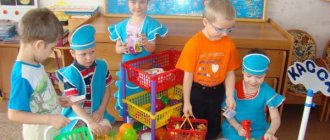“Development of communication skills and speech in young children”
In addition to such short conversations caused by circumstances, the teacher provides for specially organized planned conversations
which can be individual and collective.
To develop speaking skills, verbal instructions are used.
The teacher gives a sample verbal request, asking the child to repeat it, finding out whether he remembers the phrase. Instructions help reinforce forms of polite speech.
Adult
who has high competence in communication is the most likely
model for a child
. Moreover, he is not just a role model. Perceiving the norms and style of interaction that an adult demonstrates, the child accepts them as natural and builds his own style of communication on their basis. For example, in the game “Let's get acquainted!” An adult, demonstrating an example of speech behavior, changes the structure of the question each time. He addresses one child with the words “What is your name?”, another – “Say your name!”, a third he asks, “What did your parents name you at birth?” or “Are you Olya or Masha?” etc. Following this, the children themselves turn to each other, trying not to repeat what the other child has just said, but to come up with their own version of the question (it is this “search” that acts as a goal for him).
To develop the initial forms of speech, the teacher organizes a joint examination of pictures, children’s drawings, and books
.
Short stories from the teacher can stimulate dialogue on a specific topic.
(what he observed on the tram, what he saw interesting in another kindergarten), which evoke similar memories in the children’s memory.
A very effective technique is to unite children of different ages.
, organizing a visit to another group. Guests ask about the little owners’ toys, books, etc.
In the course of directly organized activities, it is not always possible to create effective motivation for children's speech, which results in low speech activity in children. Children for the most part do not speak out on their own, but only in obedience to the demands of an adult. The question-and-answer form of speech is the most common. Moreover, the adult turns out to be the only interlocutor of the children, which contradicts the psychological nature of the child. The child’s priority is communication with peers. A child’s creative activity manifests itself primarily in play.
. Play and work, transformed into play, taking place in a team, provide extremely favorable conditions for the development of language. Play develops language, and language organizes play. A child playing alone speaks and instinctively uses language as the most advanced means of establishing communication with the environment. The teacher must first adapt the children's play to the interests of their language development. Role-playing games “to the family”, “to kindergarten”, “to the store”, as well as on military topics reinforce speaking skills and introduce professional vocabulary. The teacher should help deepen the content of games with such attributes as telephone, information desk, cash register.
Communicative activities and pre-verbal forms of communication
The baby understands pointing and prohibiting gestures, and also performs some communicative actions: waves his hand when saying goodbye, imitating an adult, uses a pointing gesture to make a request. At this age, a system of pre-verbal forms of communication is actively developing, which includes sounds (vocalizations), facial expressions, voluntary body movements, gestures and glances (“pointing”, “seeking evaluation”, “connecting”). A delay in the formation or complete absence of the corresponding paralinguistic structures at the end of the first year of life indicates serious violations of the communicative function of speech.
A normally developing child develops an understanding of addressed speech: he responds with action to verbal requests (for example, clapping his hands when hearing the word “okay”), nodding his head as a sign of “agreement-disagreement.” By 12 months, verbal communication appears using the first words, usually denoting close people, a favorite toy, or a frequently performed action.
Cognitive development
The child develops the first visual and effective ideas, which are the sensory-perceptual basis for the formation of generalized thinking and speech in young children. A special form of activity of an infant is imitation (movements, gestures, facial expressions, voice, simple words) of an adult, which becomes conscious and varied at the end of the first year of life.
With severe disorders of psycho-emotional and cognitive development, the following are observed:
- unexpressive and monotonous facial expressions;
- emotional manifestations in the form of chaotic motor activity or oral synkinesis;
- inadequate reactions to speech, verbal instructions, or demonstrated action.
Speech therapy examination
The most important diagnostic parameters for assessing a child’s speech development by the age of 1 year are:
— priority acquisition of the basic pragmatic aspects of human communication
(the baby looks into the eyes of the interlocutor, follows the order of “statements”, nods his head - “agree/disagree”, waves his hand - “goodbye”, etc.);
— good understanding of spoken language
(knows his name, understands simple questions, reacts to prohibitions, follows simple instructions);
— completion of the babbling stage
(active babbling, its intonation coloring and proximity to the expressive melodic-rhythmic features of the speech of adults, the transition from the autolalic stage of babbling to babbling dialogues with mother, imitation of new syllables);
— the appearance of the first words and the transition to speech communication
(in babbling, the first words are distinguished, which are close in structure to babbling; imitation of significant words of adults in the form of several simplified words develops);
— conditions that most influence the activation of a child’s sound/speech activity:
tactile-emotional, emotional-speech, objective-active communication between a child and an adult or a combination of these forms (Yu.A. Razenkova, 1998);
— development of basic swallowing and chewing skills.
It is advisable to conduct a survey of parents and analysis of the results of observation of a child in the first year of life based on the general patterns of development of the infant’s first mental reactions in ontogenesis, their dependence on the formation of motor functions, the child’s somatic health and other factors (for example, characteristics of emotional relationships in the family).
Any violations of the vocal, respiratory or articulatory component of the pronunciation aspect of speech identified in an infant require timely corrective measures, additional examination of the child by other specialists (neurologist, otolaryngologist, audiologist), and difficulties in the formation of communicative activity require consultation with a child psychologist.
Books
If you want to understand in more detail the topic of developing children’s communication skills, pay attention to the following books:
- “Development of communication abilities in preschool children” Larisa Chernetskaya.
- “Communication with difficult children” Anton Makarenko.
- “Pedagogical poem” Anton Makarenko.
- “Development of communication abilities and socialization of children of senior preschool age” Svetlana Konovalenko, Maria Kremenetskaya.
- “Developing memory with a neuropsychologist” Anastasia Suntsova, Svetlana Kurdyukova.
- "Don't growl at the dog!" Karen Pryor.
- “How to talk so that children will listen, and how to listen so that children will talk” by Adele Faber, Elaine Mazlish.
We wish you good luck!
Did you like the article? Join our communities on social networks or our Telegram channel and don’t miss the release of new useful materials: TelegramVKontakteFacebook
We also recommend reading:
- Storytelling
- How to motivate a child to read?
- Development of communication skills
- How to teach a child to read: rules, tips and tricks
- Masaru Ibuka “After three it’s too late” - summary
- Play therapy when working with children
- Positive therapy for children
- Development of communication skills
- How to communicate with anyone, anywhere?
- Exercises for memory development in preschoolers
- Exercises for the brain. Part two
Key words:1Children





